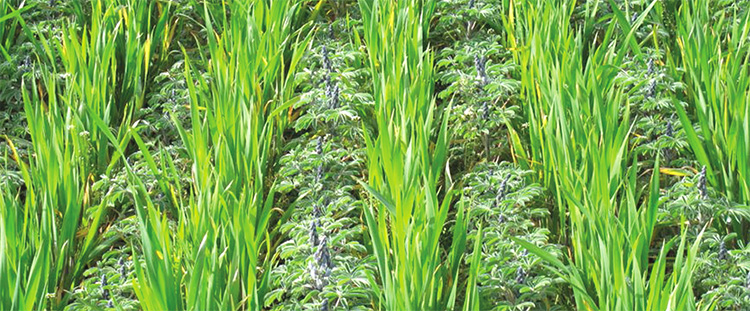"Mixed cropping is a real possibility in low input agriculture"
ETSIAAB professor Inés Mínguez has coordinated UPM's cooperation in a European project to improve the farm management of different species in the same field.
June, 2021
Mixed cropping or intercropping is the practice of seeding two or more species in the same field. This formula increases biodiversity and may reduce losses due to weeds, pests and diseases. It can also promote crop resilience when facing environmental fluctuations. DIVERSify research project is coming to an end after four years. Its goal has been getting to know how to improve the yielding and sustainability of this agricultural system. The Universidad Politécnica de Madrid (UPM) is one of the 23 partners responsible for its development. It has received funding from the European Horizon 2020 programme, and the Instituto James Hutton (UK) has led it. Inés Mínguez, professor at the Escuela Técnica Superior de Ingeniería Agronómica, Alimentaria y de Biosistemas (ETSIAAB), has coordinated the UPM's participation in this research project. She argues that mixed cropping is "a real possibility" in low input agriculture "that should be further explored".

Inés Mínguez.
What are the main advantages of mixing species in the same field?
Under certain conditions, mixed cropping may have some advantages. Nevertheless, we should not generalise; these advantages may not arise every year. Mixing crops means competition for light, water and nutrients. Therefore, a balance must be struck that will vary from one farming system to another. Low input agriculture and low yield agriculture try to maximise positive interspecific interactions or differentiate for more nutrient uptake. This context often shows mixed cropping advantages. We can find the challenge in high input agriculture. In order to increase yielding, temporal and spatial differentiation of market space, in principle, should be maximised. Whether there can be an improvement in these yields stability or not is being assessed now. The advantages of mixtures of cereal and grain legumes in low input systems and organic farming may be various; increasing relative area equivalent, better use of soil nutrients, reducing pest and disease damage and better weed control. Some of these benefits can also happen in more intensive agriculture. In years of terminal water deficit or drought, these mixtures can help to quality fodder production. In the case of agriculture and livestock farms, animals may feed on good quality grazing.
Some pests and diseases are developing pesticide-fungicide resistance. To what extent is mixed cropping interest also a response to this threat?
Among other issues, it is a response to problems related to these resistances. It is also a way to reduce the use of pesticides and nitrogen fertilisers. We must not leave out the possibilities of plant breeding or gene editing to obtain resistant varieties and obtain varieties designed for mixed cropping.
How are the most suitable species combinations chosen?
DIVERSify has considered mostly mixtures of cereal with grain legumes. Other combinations with sunflower or rapeseed, e.g., and new forage mixtures, have also been taken into account. The cereal competes very well when absorbing nitrogen from the soil, promoting nitrogen-fixing leguminous symbioses. Besides, cereals cover the soil earlier so that weed control is improved. When measuring mixtures and proportions, some key factors are the length of the cycle and the phenology (morphological and physiological changes derived from the interaction between genotype, environment and management) of each species or variety. Fortunately, we are not starting from scratch, as we have been experimenting with the help of farmers for some years. We count on four mixtures: wheat or barley or oats and broad beans or peas, wheat and vetch, barley or wheat and lupin (here, the cereal is often used as a partner crop performing well in weed control), and maize and sunflower and soya. 50:50 are not usually the most successful mixtures, but those mixtures with more legumes, e.g. 50:70 or 40:65. These ratios refer to sowing rates in pure crops (with a single species). In mixtures grown for fodder, new varieties and a more significant number of species have been evaluated. On the other hand, partner crops should be compared with monospecific crops in more diverse rotations; also with strip cropping, i.e., several possibilities to increase farming system diversity over time and spatially.

Mixed cropping of wheat and lupin
Do mixed cropping complicate matters to farmers?
There are indeed barriers that complicate matters to farmers. This project has studied how to solve them. Some adaptations would imply investments by farmers, although, in this context, it should be noted that precision agriculture has some advantages. These barriers relate firstly to sowing (seed size and rate, depths, and even sowing date). Secondly, crop management (how nutrients are managed and how pests, diseases, and weeds are controlled). Finally, harvesting (although there should be no major problems if the cycles are well synchronised). Seed separation need not be complex, although the critical issue would be, as a matter of example, would flour mills be willing to include a small percentage of legume in their product, or what would be the consumer acceptance?
Can mixed cropping be as profitable as monocultures?
Farmers seek economic returns, so if a mixture brings production costs down, even if the yield decreases, if the product has a market, it will be used. Adding crops within a crop sequence, i.e. a rotation should also be considered as emphasised by farmers who have participated in the project. The project has been developed during rotations with the evolution of pests, diseases and weeds.
Financial support remains essential for implementing more sustainable measures.
In this case, farmers risk experimenting with farming systems not well developed or entering markets not well established. They may get lower yields or lower profits until they establish optimal mixes and ratios. They also may need to invest in adaptations, machinery or new tools. Besides, the varieties they use have been selected for pure or monospecific crops... As I see it, the eco-schemes (aid for practices aimed at improving the sustainability of farms) of the new CAP should support these practices. As the 'Farm to Fork strategy' seeks, the farmer who works with mixed crops (“plant teams”) achieves greater diversity and can reduce nitrogen fertilisers and phytosanitary products. Furthermore, when plant teams incorporate a legume, it can lead to more outstanding vegetable protein production, another EU goal.
What about the exchange of experiences with the farmers involved in the project, how has it been like?
Participatory research, where farmers are involved in the research projects, has been crucial when exploring these farming systems. This collaboration is already familiar to agronomy projects; there is no other option. In DIVERSify, 35 farmers have carried out 41 on-farm trials in Denmark, Great Britain, Austria, Switzerland, Portugal, Spain and Italy. The knowledge and experience of these farmers have been crucial. The joint work has concluded that mixed cropping is a real possibility to be further explored. We have shown that losses due to pests, diseases or weeds can be reduced and nitrogen fertilisation as well. A cluster of Horizon 2020 projects on cropping systems diversification has also created exciting knowledge. To decide whether to apply them will be up to the farmers, but it all depends on the consumers.
Additional information
- European Innovation Partnership 'Agricultural Productivity and Sustainability' (EIP Agri). Project DIVERSify practices.

